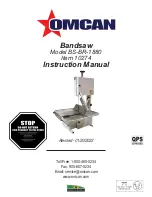
3. Regularly check the tool cable and have it replaced by an author-
ized specialist if it is damaged.
4. Regularly check the extension cables and replace them if they are
damaged.
5. Keep handles dry and free from oil and grease.
Pull the plug out of the socket:
1. When the tool is not in use, before maintenance and when chang-
ing tools such as the saw blade, drill or milling cutters, always take
the plug out of the socket.
Do not leave any tool spanners or setting keys in place.
1. Before switching on always check that spanners, keys and setting
tools have been removed.
Avoid unintentional starting.
1. Always make sure that the switch is in the OFF position when you
plug the tool into the socket.
Extension cables in the open air.
1. In the open air always use extension cables which are authorized
for the purpose and which are correspondingly marked.
Always be attentive.
1. Be aware of what you are doing. Carry out your work sensibly. Do
not use the tool if you are tired.
Check the tool for damage.
1. Before further use of the tool, examine protective devices or
slightly-damaged parts to ensure that the function is perfect and
meets the requirements.
2. Check that the moving parts function perfectly and do not stick and
that parts are not damaged. All parts must be correctly mounted
and all the conditions fulfilled to ensure trouble-free tool operation.
3. Damaged protective equipment and parts must be properly repaired
or exchanged by an authorized specialist workshop if no other infor-
mation is given in the instructions for use.
4. Arrange for damaged switches to be exchanged by a customer
services workshop.
5. Never use tools on which the switch cannot be switched on and off.
WARNING!
1. The use of other tool inserts and accessories can present a risk of
injury.
Arrange for your tool to be repaired by a specialist electrician
1. This tool meets the relevant safety regulations. Repairs may only be
carried out by electrical specialists and original spare parts must be
used. Otherwise accidents can happen to the user.
3 Legend (Fig. 1)
1. Adjusting knob for saw blade tension
2. Saw blade holder, top
3. Saw blade
4. ON - OFF switch
5. Adjusting knob for number of strokes
6. Screw for fine setting of the work table’s angle of rotation
7. Die-cast steel pedestal
8. Air nozzle
9. Die-cast steel machine body
10. Rotatable saw table
11. Saw blade holder, bottom
12. Holes for fastening screws
13. Slide blocks for clamping the saw blade
14. Rubber connecting piece for vacuum cleaner connection
15. Mains cable
16. Induction motor
17. Saw arm (top)
18. Saw arm (bottom)
19. Recesses for the slide blocks
20. Lock lever
21. Clamping screw for lock lever
22. T-handle key
23. Hose
24. Clamping screw for air nozzle alignment
25. Dust suction connection
26. Arm for saw blade guard
27. Clamping screw for saw blade guard
28. Saw blade guard
4 Description of the Machine
(see also fig. 1a and 1b)
The PROXXON scroll saw is a very sturdy, ruggedly designed but nev-
ertheless mechanically very sophisticated and carefully produced
device. The heavy die-cast pedestal and the rigid die-cast machine
body form a solid base for the complex machine mechanics and a per-
fect platform for the precision mounting of the saw arms which are
made of ultra-light but strong magnesium in order to reduce the moved
weights. They are driven by a quiet, powerful induction motor which
can be adapted to the required material properties with two speeds
(900/1400 rpm) for optimum smooth running and low vibration.
Your DS 460 has many areas of application and is particularly suitable
for mould construction, fine mechanics, model building and toy manu-
facture. It is therefore just the right tool for ambitious model builders,
designers, architects (model building) or carpenters.
The large tiltable saw table for mitre cuts of -5 to 50° is made of die-
cast aluminium for maximum accuracy and stability and precision
ground for optimum gliding characteristics. Its special design also sim-
plifies changing of the saw blade.
The saw table can be unlocked and pushed back to improve the acces-
sibility of the lower saw blade attachment. This enables quick and easy
changing of the saw blades.
Saw blades with both pin ends and flat ends can be used. The use of
sliding blocks allows precise guiding of the saw blade without interfer-
ence from bending forces.
You will find the appropriate saw blades for the respective job in the
Proxxon range of accessories. We recommend you to use Proxxon
saw blades exclusively!
The DS 460 saws soft wood up to a thickness of 50 mm, plastic up to
30 mm and non-ferrous metals up to 10 mm.
The saw can also be used to easily cut plexiglass, GRP, foam, rubber,
leather and cork.
And there is an automatically driven bellows with an adjustable air noz-
zle to ensure that dust does not obstruct the view of the cutting line
during work.
A vacuum cleaner can be connected additionally. This guarantees
clean working.
5 Technical Data:
Number of strokes:
900 or 1,400/min
Lifting height:
18 mm
Max. cutting depth:
60 mm
(in wood) at 45°:
35 mm
Saw blade length:
127 mm (with pin end)
125-130 mm (without pin end)
Noise development:
< 70 dB(A)
Vibration
< 2.5 m/s
Weight:
approx. 20 kg
Dimensions:
LxWxH
580 x 320 x 300 (in mm, approx. data)
Table:
400 x 250 mm
Throat:
460 mm
Motor:
Voltage:
220/240 V, 50/60 Hz
Power input:
145/205 W
13
Содержание DS 460
Страница 1: ...DS 460 Manual ...
Страница 10: ...78 Spare Parts List PROXXON DS460 ET Nr Description ET Nr Description ...






























